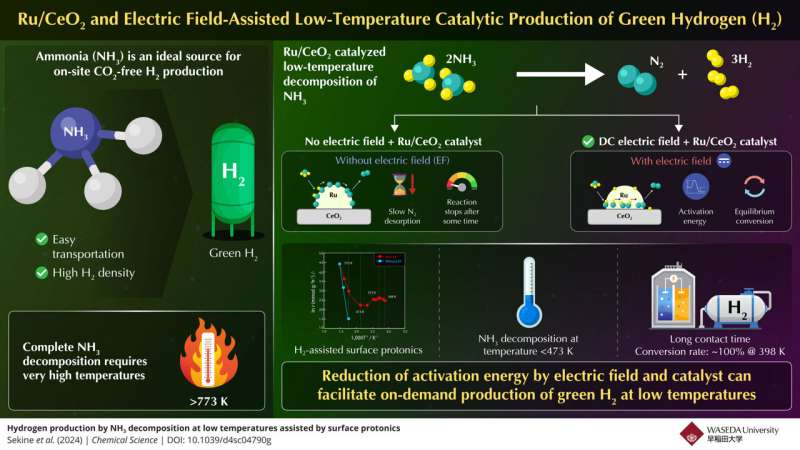Hydrogen gas, owing to its high energy density and carbon-free nature, is gaining much attention as the energy source for a green and sustainable future. Despite being the most abundant element in the universe, hydrogen is mostly found in a bound state as chemical compounds such as ammonia, metal hydrides, and other hydrogenated compounds.
Among all the hydrogen carriers, ammonia stands out as a promising candidate owing to its wide availability, high hydrogen content with hydrogen making up 17.6% of its mass, and ease of liquefaction as well as transportation.
A major drawback that hinders its exploitation as an on-demand green hydrogen source for practical applications is the need for extremely high temperatures (>773K) for its decomposition. Hydrogen production for fuel cells and internal combustion engine usage calls for high ammonia conversion rates at low temperatures.
To solve this problem, a new compact process that could operate at a lower temperature was presented by Professor Yasushi Sekine from Waseda University, with his team including Yukino Ofuchi and Sae Doi from Waseda University, and Kenta Mitarai from Yanmar Holdings. They demonstrated an experimental setup of a high rate of ammonia-to-hydrogen conversion at remarkably lower temperatures by applying an electric field in the presence of a highly active and readily producible Ru/CeO2 catalyst.
This study was published in Chemical Science on August 27, 2024.
“This is a collaborative project between our laboratory at Waseda University and Yanmar Holdings which is a leading company in ammonia utilization. We aimed to develop a process that would enable us to exploit the ability of ammonia to generate hydrogen on-demand,” states Sekine.
“So, we started investigating conventional thermal catalytic systems where the reaction proceeds through N and H adsorbate formation through dissociation of N–H bonds and the recombination of the adsorbates to form respective N2 and H2 gases.”
The team observed that the rate-determining step on an active metal Ru was the desorption of nitrogen at low temperatures and the dissociation of N–H at high temperatures. Their effort to overcome this issue led them to electric field-assisted catalytic reactions. This technique improved the proton conduction at the surface of the catalyst and reduced the activation energy required for the reaction along with its reaction temperatures to facilitate efficient ammonia conversion.
Using this information, the team designed a novel thermal catalytic system for low-temperature decomposition of ammonia to hydrogen assisted by easily producible Ru/CeO2 catalyst and DC electric field. They found that their proposed strategy efficiently decomposed ammonia even below 473 K.
Given a long enough contact time between the ammonia feed and the catalyst, 100% conversion rate was achieved at 398 K, surpassing the equilibrium conversion rate. This was attributed to the electric field’s ability to promote surface protonics—proton hopping on the catalyst surface assisted by a DC electric field. This lowers the apparent activation energies of the ammonia conversion reaction.
In contrast, they observed that the lack of an electric field significantly slowed down the nitrogen desorption process, causing the ammonia decomposition reaction to stop after some time. The significance of surface protonics in improving ammonia conversion rate was further supported by the experimental and density functional theory calculations carried out by the researchers.
This new strategy demonstrates that green hydrogen can be produced from ammonia at low temperatures with an irreversible pathway, ensuring almost 100% conversion at high reaction rates.
“We believe that our proposed method can accelerate the widespread adoption of clean alternative fuels by making the on-demand synthesis of CO2-free hydrogen easier than ever,” concludes Sekine.
More information:
Yukino Ofuchi et al, Hydrogen production by NH3 decomposition at low temperatures assisted by surface protonics, Chemical Science (2024). DOI: 10.1039/D4SC04790G
Provided by
Waseda University
Citation:
Low-temperature ammonia-to-hydrogen conversion achieved by applying an electric field (2024, September 24)
retrieved 24 September 2024
from https://phys.org/news/2024-09-temperature-ammonia-hydrogen-conversion-electric.html
This document is subject to copyright. Apart from any fair dealing for the purpose of private study or research, no
part may be reproduced without the written permission. The content is provided for information purposes only.

